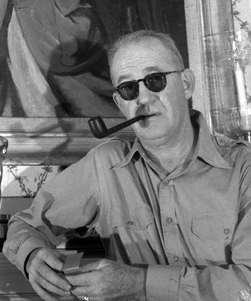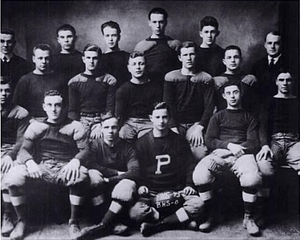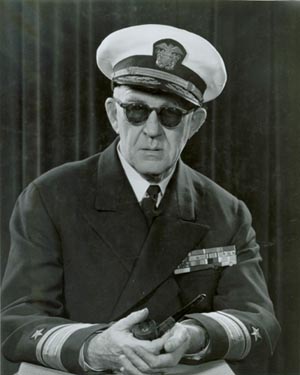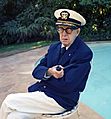John Ford facts for kids
Quick facts for kids
John Ford
|
|
|---|---|

Ford in 1946
|
|
| Born |
John Martin Feeney
February 1, 1894 Cape Elizabeth, Maine, U.S.
|
| Died | August 31, 1973 (aged 79) Palm Desert, California, U.S.
|
| Cause of death | Stomach cancer |
| Resting place | Holy Cross Cemetery, Culver City, California |
| Occupation | Film director/producer |
| Years active | 1917–1966 |
| Spouse(s) |
Mary McBride Smith
(m. 1920) |
| Children | 2 |
| Military career | |
| Allegiance | |
| Service/ |
US Navy US Naval Reserve |
| Years of service | 1942–45 (active) 1946–62 (reserve) |
| Rank | Commander (active) Rear Admiral (reserve) |
| Battles/wars | World War II Battle of Midway |
John Ford (born John Martin Feeney; February 1, 1894 – August 31, 1973) was a famous American film director. He is known for directing many classic movies, especially Westerns. Some of his most famous Westerns include Stagecoach (1939) and The Searchers (1956).
Ford also directed movies based on popular American books, like The Grapes of Wrath (1940). He won a record four Academy Awards for Best Director. One of his winning films, How Green Was My Valley, also won the Best Picture award.
John Ford worked in movies for over 50 years. He directed more than 140 films. Many people consider him one of the most important directors of his time. Other famous directors, like Orson Welles, thought he was one of the greatest ever. Ford often filmed movies outdoors, using wide shots to show characters against huge, natural landscapes.
Contents
Early Life and Beginnings
John Ford was born in Cape Elizabeth, Maine. His birth name was John Martin Feeney. When he was young, he went to Portland High School, Portland, Maine. He was a good football player, known for being a strong fullback. People called him "Bull" because of how he played.
In 1914, he moved to California. He started working in the film industry with his older brother, Francis. John began acting and working behind the scenes. He started using the name "Jack Ford" for his work.
In 1920, John Ford married Mary McBride Smith. They had two children together. Their marriage lasted throughout his life.
Directing Silent and Sound Films
John Ford started directing movies in 1917. His first films were made during the "Silent Era." This was a time when movies did not have recorded sound.
Ford was very busy in his early directing years. He made many short films and features. Between 1917 and 1928, he directed 62 films. He became known for being very efficient.
He was also one of the first directors to make sound films. In 1928, he directed Mother Machree, which had the first song sung on screen for Fox studios. This film also featured a young John Wayne as an extra.
Ford loved to film his Western movies in Monument Valley in southern Utah. Even though the landscape didn't always match the stories, its amazing look helped him create iconic images of the American West. His films showed beautiful and powerful scenes of nature.
By 1940, John Ford was recognized as one of the world's leading movie directors. He was known for making artistic films that were also popular with audiences.
John Ford's War Service
During World War II, John Ford joined the United States Navy. He was a Commander and led a photography unit for the Office of Strategic Services. He made documentaries for the Navy.
He won two more Academy Awards during the war:
- The Battle of Midway (1942)
- December 7th: The Movie (1943)
Ford was at the Battle of Midway and was even wounded while filming the Japanese attack. He was also present on Omaha Beach during D-Day. He filmed the battle from the ship and later on the beach. His superiors praised him for his bravery while filming in dangerous areas.
After the war, Ford continued to serve in the United States Navy Reserve. He returned to active duty during the Korean War. He was promoted to Rear Admiral when he left the service.
Later Life and Legacy
In the early 1970s, John Ford's health declined. He used a wheelchair after breaking his hip. He was treated for cancer at Eisenhower Medical Center.
In October 1972, the Screen Directors Guild honored him. In March 1973, the American Film Institute gave him its first Lifetime Achievement Award. This ceremony was shown on TV. President Richard Nixon promoted Ford to full Admiral and gave him the Presidential Medal of Freedom.
John Ford passed away on August 31, 1973, in Palm Desert, California. His funeral was held in Hollywood. He was buried in Holy Cross Cemetery in Culver City, California.
Images for kids
-
The Searchers (1956)
-
John Ford's Point in Monument Valley
See also
 In Spanish: John Ford para niños
In Spanish: John Ford para niños









